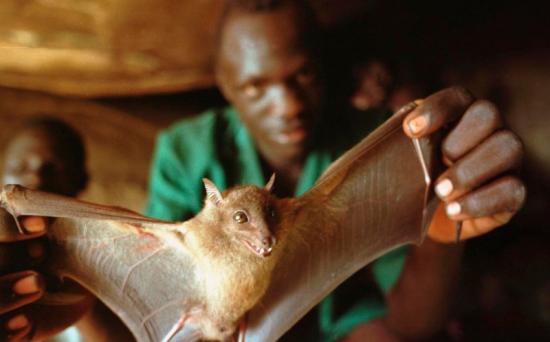You are here
 THE DAILY BEAST Nov. 11, 2014
THE DAILY BEAST Nov. 11, 2014
By Carfrie Arnold
These nocturnal fliers might do some good, but their association with night, rabies, and All Things Creepy means that, at best, we tolerate them. Adding to their negative aura is recent research showing that bats can be the source of infectious diseases like SARS and Ebola, as well as lesser-known pathogens like Hendra and Nipah virus.
It’s all too easy to blame bats for causing these human pandemics, including the most recent (and deadliest) Ebola outbreak. After all, these viruses hang out in bats in between outbreaks—trace any outbreak of these viruses back far enough and you will find a bat.
But a new study reveals that the picture is much more complicated. Far from being hapless victims in outbreaks of Ebola and other infectious diseases, researchers are showing that human actions are at least as much to blame as bats.
Read complete article
http://www.thedailybeast.com/articles/2014/11/11/bats-link-to-ebola-finally-solved.html?utm_medium=referral&utm_source=pulsenews
ALso see:
Ebola-carrying bats may be heroes as well as villains
Posted Nov. 2, 2014



Comments
Ecological Dynamics of Emerging Bat Virus Spillover
rspb.royalsocietypublishing.org
Published 12 November 2014 doi: 10.1098/rspb.2014.2124 Proc. R. Soc. B 7 January 2015 vol. 282 no. 1798 20142124
Abstract
Viruses that originate in bats may be the most notorious emerging zoonoses that spill over from wildlife into domestic animals and humans. Understanding how these infections filter through ecological systems to cause disease in humans is of profound importance to public health. Transmission of viruses from bats to humans requires a hierarchy of enabling conditions that connect the distribution of reservoir hosts, viral infection within these hosts, and exposure and susceptibility of recipient hosts. For many emerging bat viruses, spillover also requires viral shedding from bats, and survival of the virus in the environment. Focusing on Hendra virus, but also addressing Nipah virus, Ebola virus, Marburg virus and coronaviruses, we delineate this cross-species spillover dynamic from the within-host processes that drive virus excretion to land-use changes that increase interaction among species. We describe how land-use changes may affect co-occurrence and contact between bats and recipient hosts. Two hypotheses may explain temporal and spatial pulses of virus shedding in bat populations: episodic shedding from persistently infected bats or transient epidemics that occur as virus is transmitted among bat populations. Management of livestock also may affect the probability of exposure and disease. Interventions to decrease the probability of virus spillover can be implemented at multiple levels from targeting the reservoir host to managing recipient host exposure and susceptibility.
(CLICK HERE - RESEARCH STUDY - Ecological Dynamics of Emerging Bat Virus Spillover)